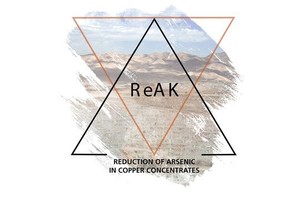New research project ReAK for the reduction of arsenic in copper concentrates
With 27 % of the global production, Chile is the largest producer and the world´s largest exporter of copper. This makes copper mining one of the country’s most important export revenues. However, it also brings significant economical as well as ecological challenges.
Copper mining in Chile – the challenge
For one thing, the concentration of copper in the ore is just 0.5 to 2 %, whereas the contamination by arsenic, antimony and bismuth can be quite high. Arsenic in particular is a highly toxic inorganic pollutant which poses a threat not only to human health but to the entire ecosystem. For this reason, some countries have set arsenic limits that require a purification of the arsenic-rich copper concentrates. Existing processes for the separation and stabilization of arsenic are not yet sufficiently economical. In addition, most of the separated arsenic is in parts water-soluble and deposited in the Atacama Desert. With the increasing effects of climate change, however, more precipitation is occurring in an otherwise dry region, causing the water-soluble arsenic to contaminate soil and groundwater and thus posing a considerable risk to humans and the environment.
Content and goals of the research project
The main objective of the project "ReAK – Reduction of Arsenic in Copper Concentrates" funded by the Federal Ministry of Education and Research is the optimization and further development of existing processes as well as the establishment of new processes for dealing with arsenic-rich copper ores and their concentrates. Special attention is given to the challenge of increasing arsenic contents in the ores and the concentrates produced from them. In the project, the entire process chain of copper extraction from copper ores is considered, from the separation of by-products to the stabilization of arsenic and the disposal of residues.
One approach is to make flotation as selective as possible with respect of arsenic, in addition to separating copper-rich and copper-poor ore fractions. Arsenic-rich copper concentrates and intermediate products are to be treated with processes for the separation and stabilization of arsenic. To this end, various approaches such as sulfidic leaching, biological leaching, various roasting processes and innovative oxidative extraction processes are being investigated and further developed. The arsenic is to be separated and transferred from As(III) to the more stable As(V). In addition, the research consortium is investigating the leaching behavior of the precipitated arsenic compounds and their stability in dependence on different climatic conditions, which will provide information on which arsenic compound is to be targeted for landfilling.
Final evaluation of the different approaches and processes
Both the ecological (Life Cycle Assessment – LCA) and economic (Life Cycle Costing – LCC) aspects are being considered across the entire process chain in order to enable a comparison of the different technically relevant and sensible processes. The findings will be summarized and will serve as a decision-making aid for the industry and the Chilean government with regard to the selection of technologies and disposal guidelines.
This will not only expand and strengthen the economic relations of both countries in the long term, but will also promote the protection of people and the environment through the sustainable disposal and implementation of appropriate barrier systems for environmentally hazardous residual materials.
The consortium
The research consortium consists of nine national partners from research and industry as well as seven international partners in Chile:
National project partners:
·Fraunhofer Research Institution for Materials Recycling and Resource Strategies IWKS (coordination)
·Aurubis AG
·Borregaard Deutschland GmbH
·EKOF Mining & Water Solution GmbH
·EnviroChemie GmbH
·Federal Institute for Geosciences and Natural Resources
·Outotec GmbH & Co.KG
·Technische Universität Bergakademie Freiberg
·Wismut GmbH
International project partners:
·Alta Ley
·EcoMetales
·German-Chilean Chamber of Commerce and Industry
·Pontificia Universidad Católica de Chile
·Sustainable Minerals Institute, International Centre of Excellence
·Universidad de Concepción
·Universidad de Santiago de Chile
The project ReAK is funded by the Federal Ministry of Education and Research (BMBF) with 2.8 million € within the framework of the funding measure "CLIENT II – International Partnerships for Sustainable Innovation" within the framework program "Research for Sustainable Development (FONA3)".


